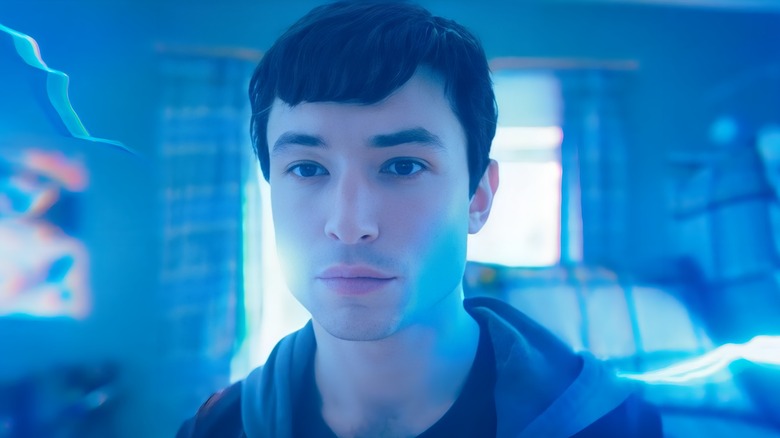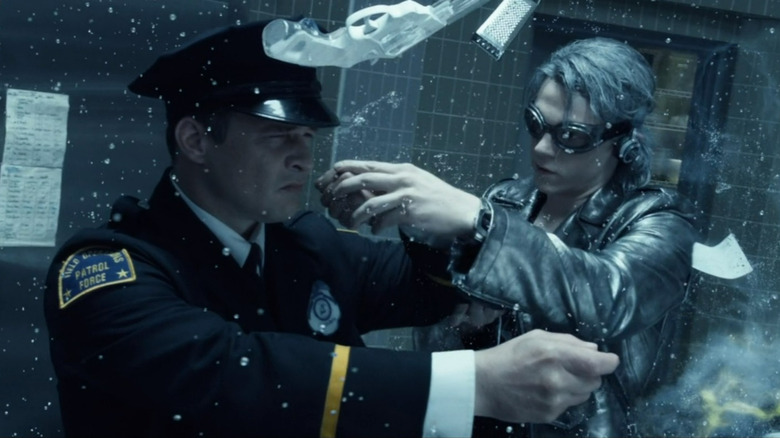The Flash Tries (And Fails) To Outrace Marvel's Best X-Men Movie Moments
Warning: This article contains spoilers for "The Flash."
There are only so many ways to showcase superspeed on film. The Marvel Cinematic Universe method sees heroes like Pietro Maximoff (Aaron Taylor-Johnson) and Makkari (Lauren Ridloff) hidden in real time beneath a thick layer of CGI motion blur. There's also the 20th Century Fox method, which is far more prevalent in modern-day Hollywood. Back in 2014, which we're going to pretend still counts as "modern day," the studio introduced audiences to Pietro Maximoff (Evan Peters), also known as Quicksilver, in "X-Men: Days of Future Past." Yes, it's the same character that later appears in the MCU. Yes, it's confusing. It's a whole thing.
Anyway, the speedster's abilities were put on hilarious display courtesy of an unforgettable slow-motion sequence in which everything but Pietro himself is slowed to a near-total halt. And in that slow motion, Pietro plays in the space, affecting it and saving lives. The scene was so well received that Fox recreated it in "X-Men: Apocalypse." And Paramount later recreated it for "Sonic the Hedgehog." And DC recreated it for "The Flash." In fairness, when Sonic (Ben Schwartz) conquered a world in slow motion, it was cute, but when Barry Allan (Ezra Miller), also known as the Flash, tried it out ... the effects were less cute. One could even go so far as to say it was downright creepy.
The Flash's slow motion sequence is tarnished by terrifying CGI
In "The Flash," Barry goes on a rescue mission for Alfred Pennyworth (Jeremy Irons) to evacuate a collapsing hospital. Batman (Ben Affleck) can't help because he's a little busy stopping a global pandemic. Naturally, there's a room on the top floor packed with babies, a therapy dog, and one understandably concerned nurse. Before Barry can save them, though, the building collapses, and the nurse, the dog, and every single one of those poor babies tumble straight through a pane of glass and out over an expanse of nothingness.
Enter the Flash. Time slows down, and he stares up in horror as the infants free fall. Functionally, the scene serves the same purpose as the scenes in 20th Century Fox's "X-Men" franchise. It shows how much the Flash can accomplish in a matter of seconds. And while it nails that aspect of the scene and even shows how silly the Flash is with his abilities, it falls flat in comparison to what's come before.
If you haven't seen "The Flash" yet, then you won't know just how unsettling the CGI really is ... it makes everything it touches appear rubbery, like Tim Allen's Toy Santa character in "The Santa Clause 2," or like every single character in "The Polar Express." In conjunction with the staging, which is very clearly attempting to be funny, the results are somewhere smack dab in the middle of the uncanny valley. You have not known fear until you've watched a swarm of CGI babies stare you down.
The Flash is best when its self referential
It would be silly to pretend as though 20th Century Fox didn't use CGI to make Quicksilver run faster than the speed of light in "X-Men: Days of Future Past" and "X-Men: Apocalypse" but his slow motion sequences utilize practical effects, too. And Evan Peters' facial expressions aren't masked by CGI, either. For whatever reason, every time Barry Allen dons his Flash costume, even the exposed lower half of his face becomes digital rubber, and that basically denies Ezra Miller any opportunity to emote realism.
And realism is difficult enough when you're trying to use a microwaveable burrito to prevent a baby from being burned to death in midair. This brings us to the last reason that "The Flash" can't keep pace with "X-Men" –- the former tries way too hard to one-up the latter without building a firm foundation of plausible action. When Quicksilver throws people around at hyperspeed, he stops their motion with mattresses, blankets, and a slew of other soft surfaces. The Flash uses two fingers and a gurney.
Imitation is the sincerest form of flattery, but maybe "The Flash" should have stuck to speed skating. That, at least, it does without equal. There's even a great moment where the film playfully acknowledges how silly the run looks without the animated trappings, and in moments like those, "The Flash" shines brightest.
"The Flash" is in theaters now.


